Business in Practice: Types, Structures, and PESTLE Analysis
VerifiedAdded on 2023/01/10
|9
|2527
|43
Report
AI Summary
This report provides a comprehensive overview of different types of businesses, including micro, small, medium, and large enterprises, as well as various business structures like sole traders, partnerships, limited liability companies, and cooperatives. It explores how organizational structures, such as functional and divisional structures, influence business profitability and productivity. Furthermore, the report delves into the impact of external factors on business performance using PESTLE analysis, examining political, economic, social, technological, environmental, and legal factors. The analysis highlights how these factors can affect a business's ability to achieve its objectives and adapt to the changing market environment. The report emphasizes the importance of understanding both internal structures and external influences for effective business management and strategic decision-making.
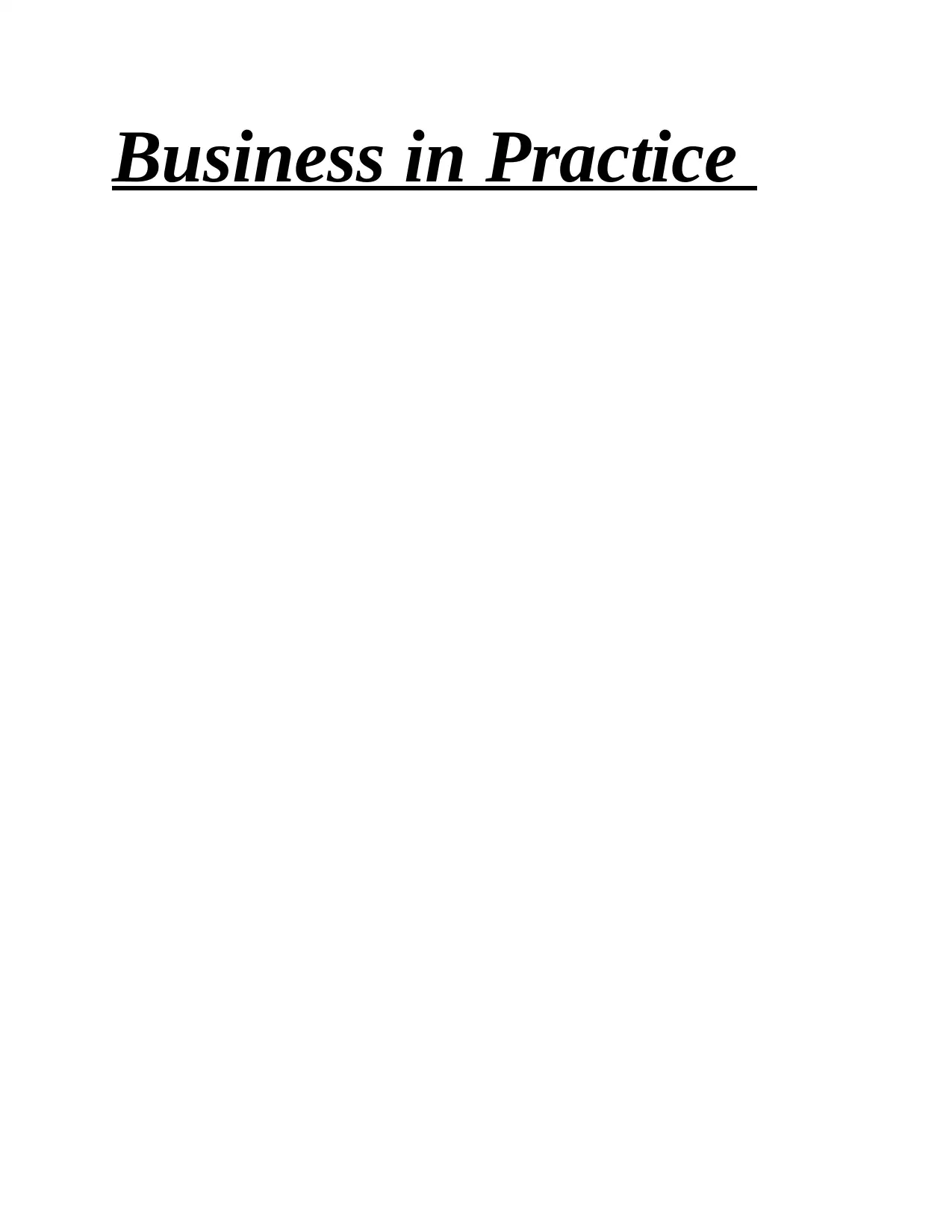
Business in Practice
Paraphrase This Document
Need a fresh take? Get an instant paraphrase of this document with our AI Paraphraser
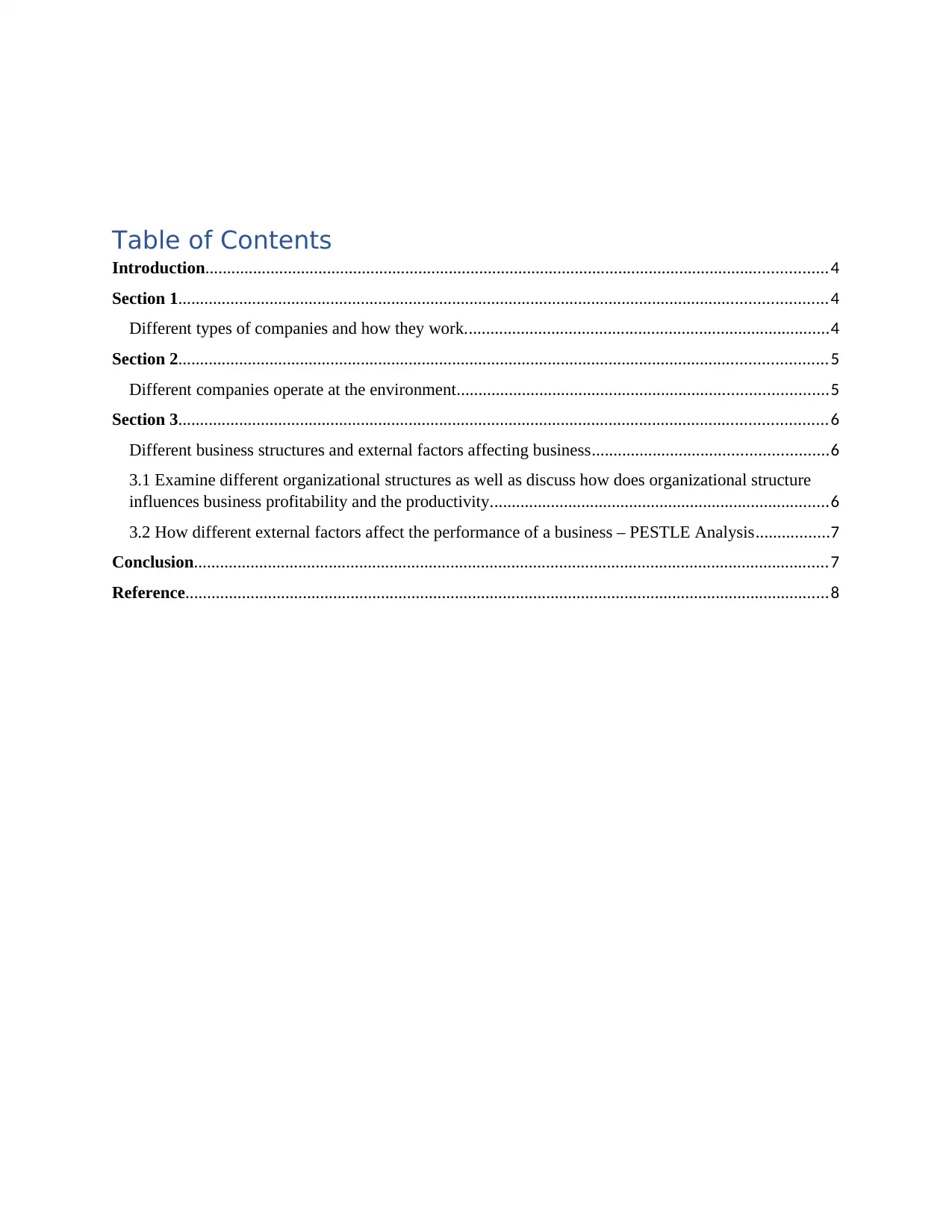
Table of Contents
Introduction...............................................................................................................................................4
Section 1.....................................................................................................................................................4
Different types of companies and how they work....................................................................................4
Section 2.....................................................................................................................................................5
Different companies operate at the environment.....................................................................................5
Section 3.....................................................................................................................................................6
Different business structures and external factors affecting business......................................................6
3.1 Examine different organizational structures as well as discuss how does organizational structure
influences business profitability and the productivity..............................................................................6
3.2 How different external factors affect the performance of a business – PESTLE Analysis.................7
Conclusion..................................................................................................................................................7
Reference....................................................................................................................................................8
Introduction...............................................................................................................................................4
Section 1.....................................................................................................................................................4
Different types of companies and how they work....................................................................................4
Section 2.....................................................................................................................................................5
Different companies operate at the environment.....................................................................................5
Section 3.....................................................................................................................................................6
Different business structures and external factors affecting business......................................................6
3.1 Examine different organizational structures as well as discuss how does organizational structure
influences business profitability and the productivity..............................................................................6
3.2 How different external factors affect the performance of a business – PESTLE Analysis.................7
Conclusion..................................................................................................................................................7
Reference....................................................................................................................................................8
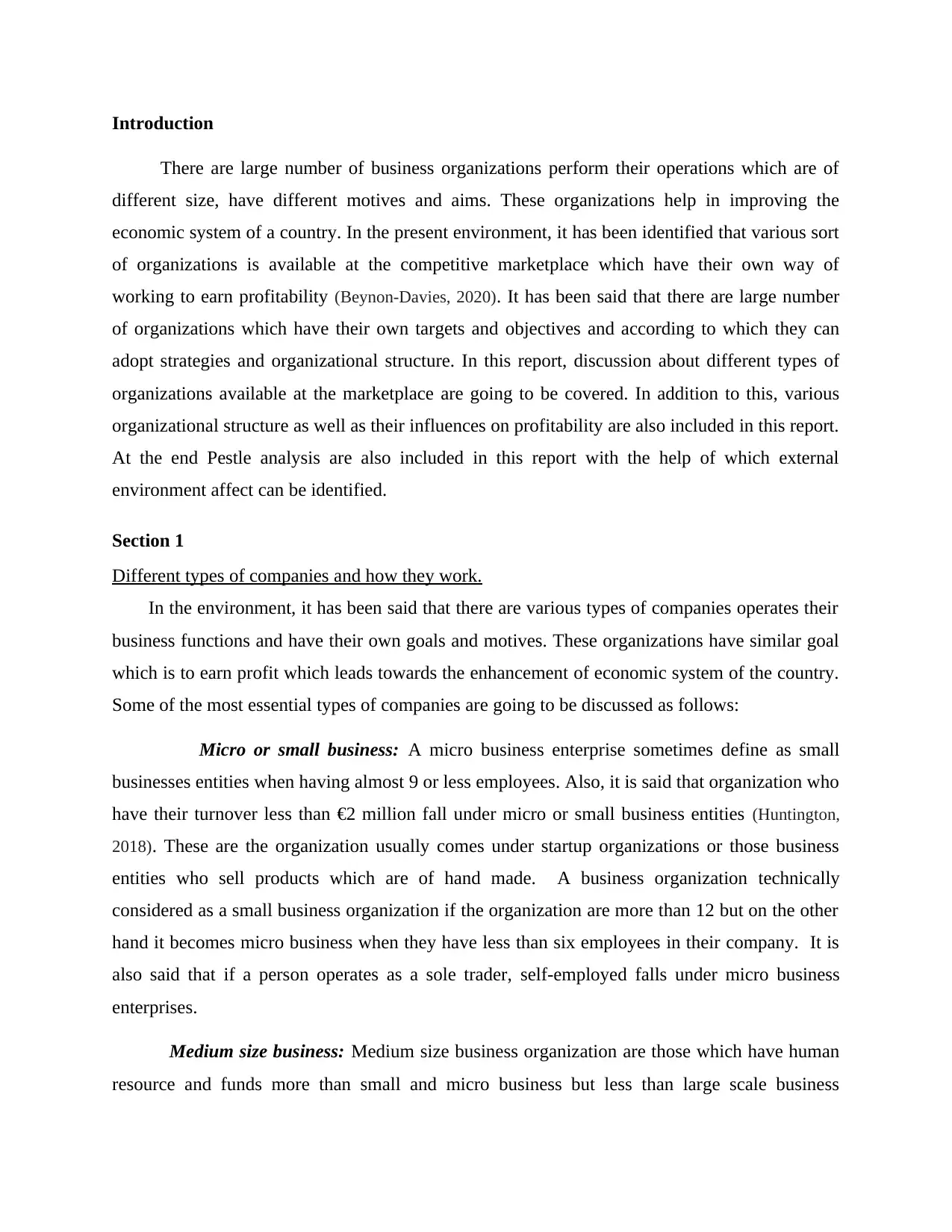
Introduction
There are large number of business organizations perform their operations which are of
different size, have different motives and aims. These organizations help in improving the
economic system of a country. In the present environment, it has been identified that various sort
of organizations is available at the competitive marketplace which have their own way of
working to earn profitability (Beynon-Davies, 2020). It has been said that there are large number
of organizations which have their own targets and objectives and according to which they can
adopt strategies and organizational structure. In this report, discussion about different types of
organizations available at the marketplace are going to be covered. In addition to this, various
organizational structure as well as their influences on profitability are also included in this report.
At the end Pestle analysis are also included in this report with the help of which external
environment affect can be identified.
Section 1
Different types of companies and how they work.
In the environment, it has been said that there are various types of companies operates their
business functions and have their own goals and motives. These organizations have similar goal
which is to earn profit which leads towards the enhancement of economic system of the country.
Some of the most essential types of companies are going to be discussed as follows:
Micro or small business: A micro business enterprise sometimes define as small
businesses entities when having almost 9 or less employees. Also, it is said that organization who
have their turnover less than €2 million fall under micro or small business entities (Huntington,
2018). These are the organization usually comes under startup organizations or those business
entities who sell products which are of hand made. A business organization technically
considered as a small business organization if the organization are more than 12 but on the other
hand it becomes micro business when they have less than six employees in their company. It is
also said that if a person operates as a sole trader, self-employed falls under micro business
enterprises.
Medium size business: Medium size business organization are those which have human
resource and funds more than small and micro business but less than large scale business
There are large number of business organizations perform their operations which are of
different size, have different motives and aims. These organizations help in improving the
economic system of a country. In the present environment, it has been identified that various sort
of organizations is available at the competitive marketplace which have their own way of
working to earn profitability (Beynon-Davies, 2020). It has been said that there are large number
of organizations which have their own targets and objectives and according to which they can
adopt strategies and organizational structure. In this report, discussion about different types of
organizations available at the marketplace are going to be covered. In addition to this, various
organizational structure as well as their influences on profitability are also included in this report.
At the end Pestle analysis are also included in this report with the help of which external
environment affect can be identified.
Section 1
Different types of companies and how they work.
In the environment, it has been said that there are various types of companies operates their
business functions and have their own goals and motives. These organizations have similar goal
which is to earn profit which leads towards the enhancement of economic system of the country.
Some of the most essential types of companies are going to be discussed as follows:
Micro or small business: A micro business enterprise sometimes define as small
businesses entities when having almost 9 or less employees. Also, it is said that organization who
have their turnover less than €2 million fall under micro or small business entities (Huntington,
2018). These are the organization usually comes under startup organizations or those business
entities who sell products which are of hand made. A business organization technically
considered as a small business organization if the organization are more than 12 but on the other
hand it becomes micro business when they have less than six employees in their company. It is
also said that if a person operates as a sole trader, self-employed falls under micro business
enterprises.
Medium size business: Medium size business organization are those which have human
resource and funds more than small and micro business but less than large scale business
⊘ This is a preview!⊘
Do you want full access?
Subscribe today to unlock all pages.

Trusted by 1+ million students worldwide
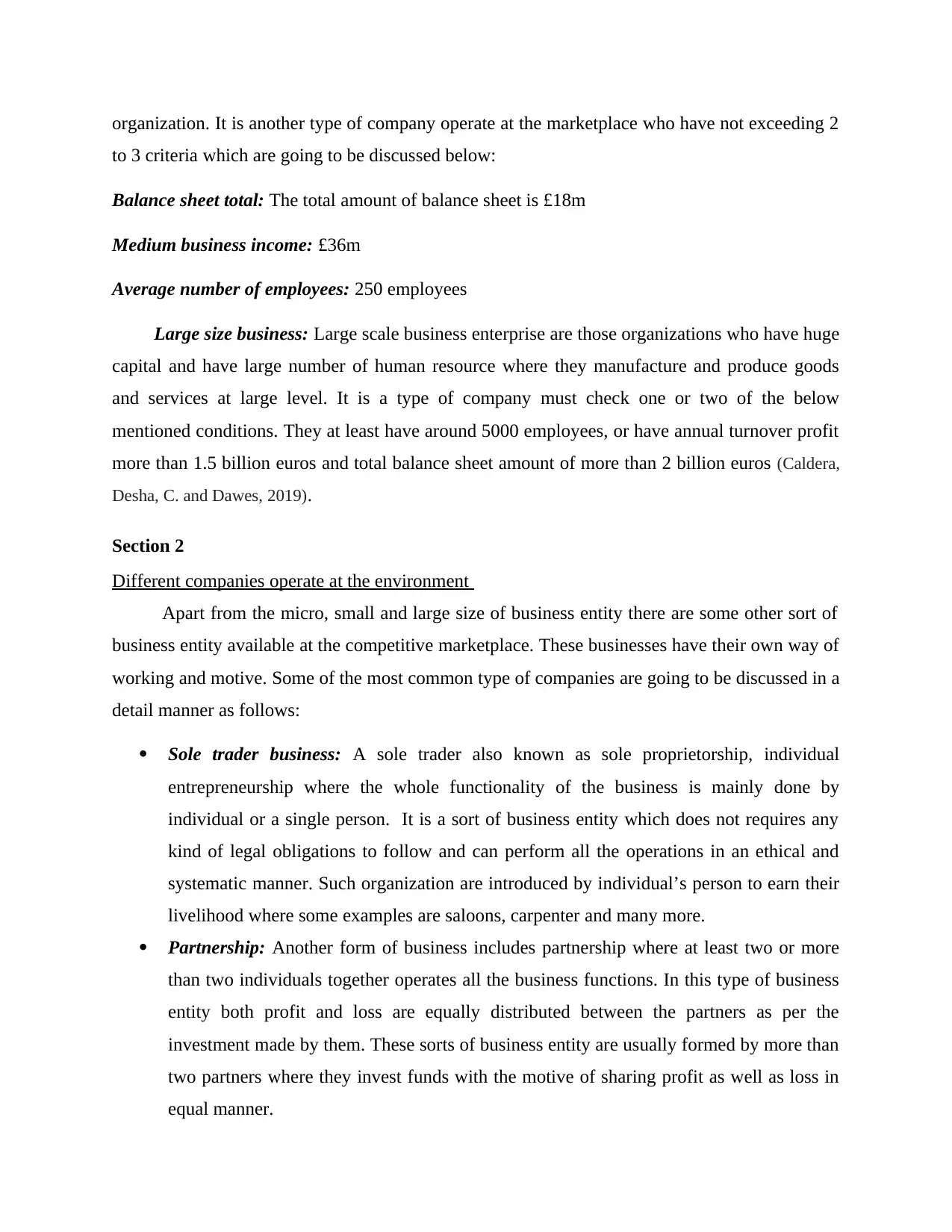
organization. It is another type of company operate at the marketplace who have not exceeding 2
to 3 criteria which are going to be discussed below:
Balance sheet total: The total amount of balance sheet is £18m
Medium business income: £36m
Average number of employees: 250 employees
Large size business: Large scale business enterprise are those organizations who have huge
capital and have large number of human resource where they manufacture and produce goods
and services at large level. It is a type of company must check one or two of the below
mentioned conditions. They at least have around 5000 employees, or have annual turnover profit
more than 1.5 billion euros and total balance sheet amount of more than 2 billion euros (Caldera,
Desha, C. and Dawes, 2019).
Section 2
Different companies operate at the environment
Apart from the micro, small and large size of business entity there are some other sort of
business entity available at the competitive marketplace. These businesses have their own way of
working and motive. Some of the most common type of companies are going to be discussed in a
detail manner as follows:
Sole trader business: A sole trader also known as sole proprietorship, individual
entrepreneurship where the whole functionality of the business is mainly done by
individual or a single person. It is a sort of business entity which does not requires any
kind of legal obligations to follow and can perform all the operations in an ethical and
systematic manner. Such organization are introduced by individual’s person to earn their
livelihood where some examples are saloons, carpenter and many more.
Partnership: Another form of business includes partnership where at least two or more
than two individuals together operates all the business functions. In this type of business
entity both profit and loss are equally distributed between the partners as per the
investment made by them. These sorts of business entity are usually formed by more than
two partners where they invest funds with the motive of sharing profit as well as loss in
equal manner.
to 3 criteria which are going to be discussed below:
Balance sheet total: The total amount of balance sheet is £18m
Medium business income: £36m
Average number of employees: 250 employees
Large size business: Large scale business enterprise are those organizations who have huge
capital and have large number of human resource where they manufacture and produce goods
and services at large level. It is a type of company must check one or two of the below
mentioned conditions. They at least have around 5000 employees, or have annual turnover profit
more than 1.5 billion euros and total balance sheet amount of more than 2 billion euros (Caldera,
Desha, C. and Dawes, 2019).
Section 2
Different companies operate at the environment
Apart from the micro, small and large size of business entity there are some other sort of
business entity available at the competitive marketplace. These businesses have their own way of
working and motive. Some of the most common type of companies are going to be discussed in a
detail manner as follows:
Sole trader business: A sole trader also known as sole proprietorship, individual
entrepreneurship where the whole functionality of the business is mainly done by
individual or a single person. It is a sort of business entity which does not requires any
kind of legal obligations to follow and can perform all the operations in an ethical and
systematic manner. Such organization are introduced by individual’s person to earn their
livelihood where some examples are saloons, carpenter and many more.
Partnership: Another form of business includes partnership where at least two or more
than two individuals together operates all the business functions. In this type of business
entity both profit and loss are equally distributed between the partners as per the
investment made by them. These sorts of business entity are usually formed by more than
two partners where they invest funds with the motive of sharing profit as well as loss in
equal manner.
Paraphrase This Document
Need a fresh take? Get an instant paraphrase of this document with our AI Paraphraser
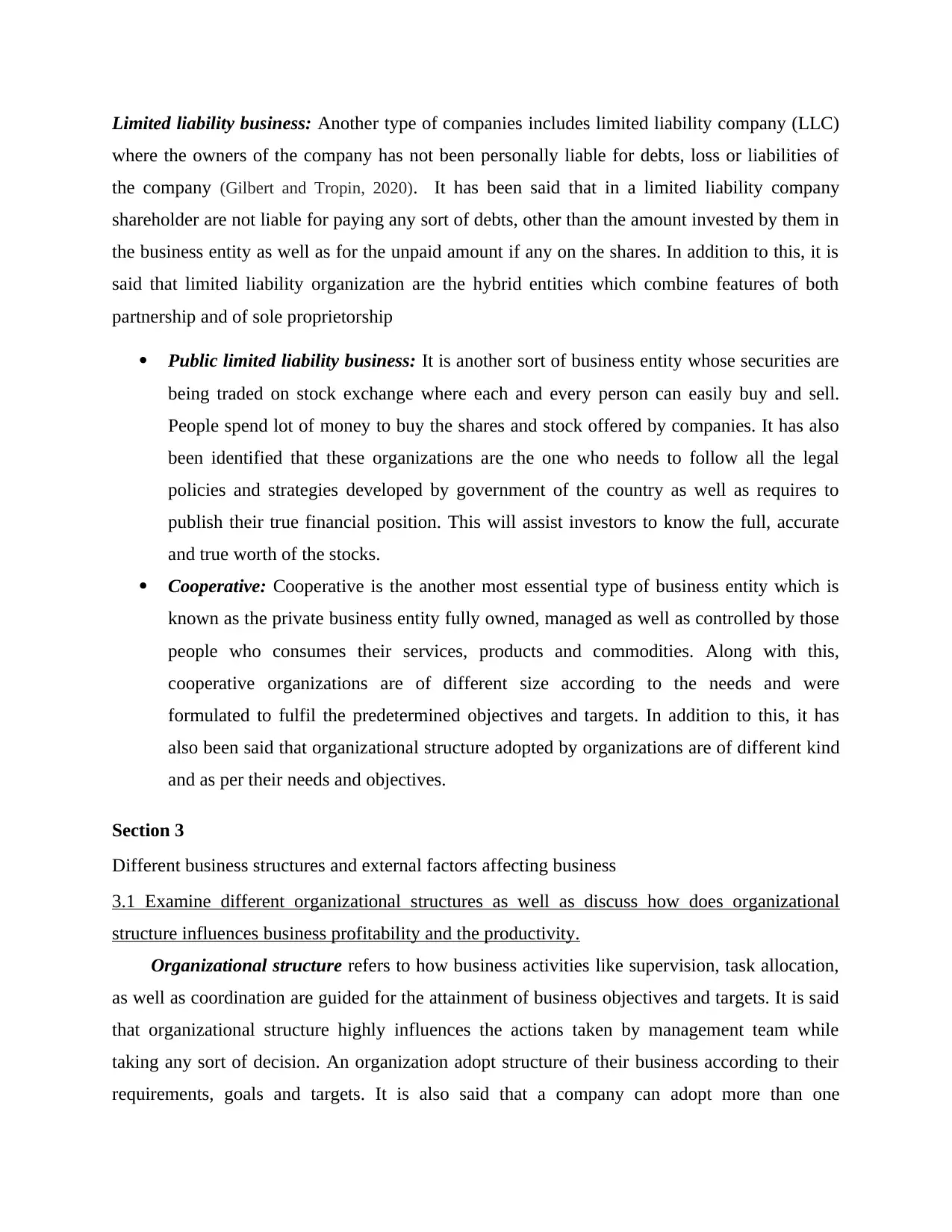
Limited liability business: Another type of companies includes limited liability company (LLC)
where the owners of the company has not been personally liable for debts, loss or liabilities of
the company (Gilbert and Tropin, 2020). It has been said that in a limited liability company
shareholder are not liable for paying any sort of debts, other than the amount invested by them in
the business entity as well as for the unpaid amount if any on the shares. In addition to this, it is
said that limited liability organization are the hybrid entities which combine features of both
partnership and of sole proprietorship
Public limited liability business: It is another sort of business entity whose securities are
being traded on stock exchange where each and every person can easily buy and sell.
People spend lot of money to buy the shares and stock offered by companies. It has also
been identified that these organizations are the one who needs to follow all the legal
policies and strategies developed by government of the country as well as requires to
publish their true financial position. This will assist investors to know the full, accurate
and true worth of the stocks.
Cooperative: Cooperative is the another most essential type of business entity which is
known as the private business entity fully owned, managed as well as controlled by those
people who consumes their services, products and commodities. Along with this,
cooperative organizations are of different size according to the needs and were
formulated to fulfil the predetermined objectives and targets. In addition to this, it has
also been said that organizational structure adopted by organizations are of different kind
and as per their needs and objectives.
Section 3
Different business structures and external factors affecting business
3.1 Examine different organizational structures as well as discuss how does organizational
structure influences business profitability and the productivity.
Organizational structure refers to how business activities like supervision, task allocation,
as well as coordination are guided for the attainment of business objectives and targets. It is said
that organizational structure highly influences the actions taken by management team while
taking any sort of decision. An organization adopt structure of their business according to their
requirements, goals and targets. It is also said that a company can adopt more than one
where the owners of the company has not been personally liable for debts, loss or liabilities of
the company (Gilbert and Tropin, 2020). It has been said that in a limited liability company
shareholder are not liable for paying any sort of debts, other than the amount invested by them in
the business entity as well as for the unpaid amount if any on the shares. In addition to this, it is
said that limited liability organization are the hybrid entities which combine features of both
partnership and of sole proprietorship
Public limited liability business: It is another sort of business entity whose securities are
being traded on stock exchange where each and every person can easily buy and sell.
People spend lot of money to buy the shares and stock offered by companies. It has also
been identified that these organizations are the one who needs to follow all the legal
policies and strategies developed by government of the country as well as requires to
publish their true financial position. This will assist investors to know the full, accurate
and true worth of the stocks.
Cooperative: Cooperative is the another most essential type of business entity which is
known as the private business entity fully owned, managed as well as controlled by those
people who consumes their services, products and commodities. Along with this,
cooperative organizations are of different size according to the needs and were
formulated to fulfil the predetermined objectives and targets. In addition to this, it has
also been said that organizational structure adopted by organizations are of different kind
and as per their needs and objectives.
Section 3
Different business structures and external factors affecting business
3.1 Examine different organizational structures as well as discuss how does organizational
structure influences business profitability and the productivity.
Organizational structure refers to how business activities like supervision, task allocation,
as well as coordination are guided for the attainment of business objectives and targets. It is said
that organizational structure highly influences the actions taken by management team while
taking any sort of decision. An organization adopt structure of their business according to their
requirements, goals and targets. It is also said that a company can adopt more than one
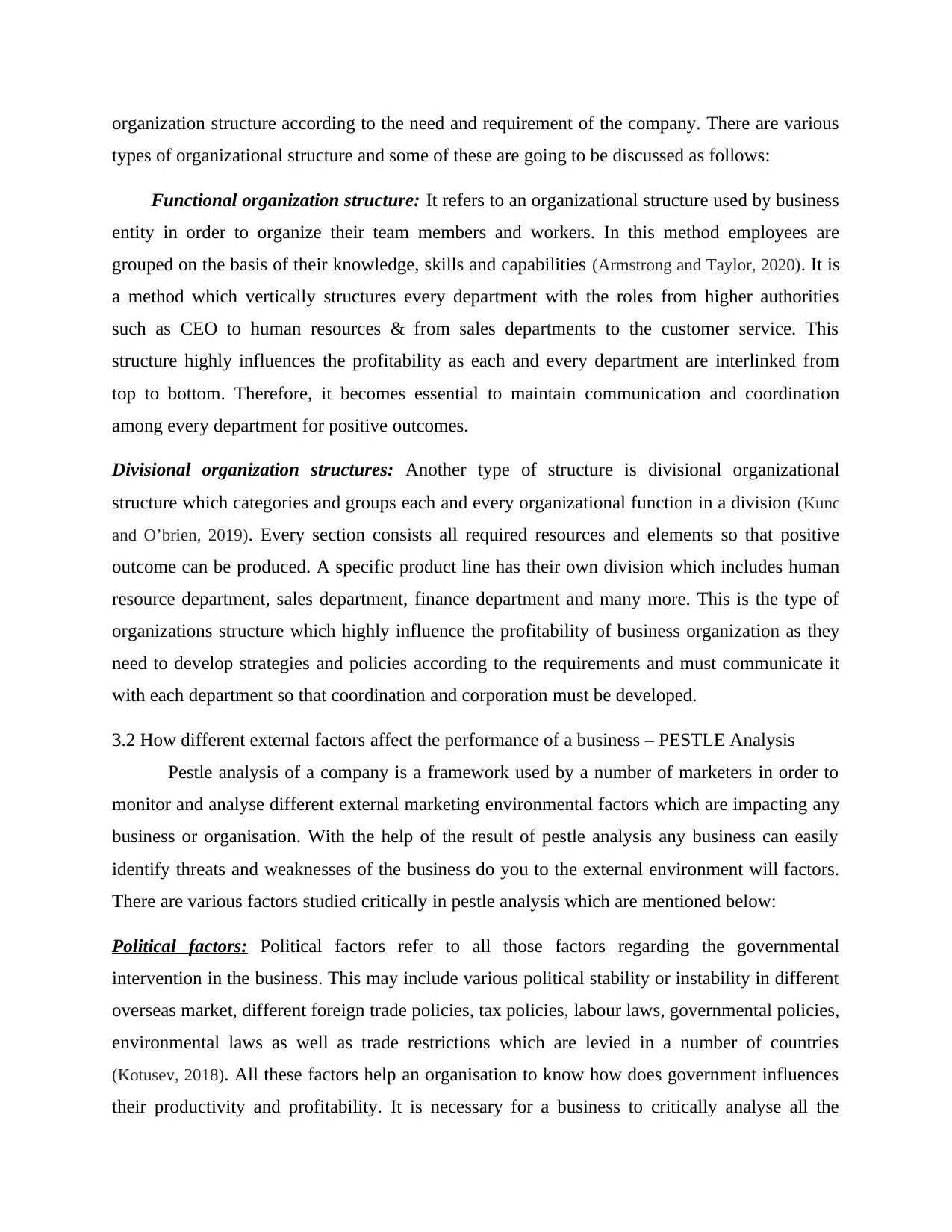
organization structure according to the need and requirement of the company. There are various
types of organizational structure and some of these are going to be discussed as follows:
Functional organization structure: It refers to an organizational structure used by business
entity in order to organize their team members and workers. In this method employees are
grouped on the basis of their knowledge, skills and capabilities (Armstrong and Taylor, 2020). It is
a method which vertically structures every department with the roles from higher authorities
such as CEO to human resources & from sales departments to the customer service. This
structure highly influences the profitability as each and every department are interlinked from
top to bottom. Therefore, it becomes essential to maintain communication and coordination
among every department for positive outcomes.
Divisional organization structures: Another type of structure is divisional organizational
structure which categories and groups each and every organizational function in a division (Kunc
and O’brien, 2019). Every section consists all required resources and elements so that positive
outcome can be produced. A specific product line has their own division which includes human
resource department, sales department, finance department and many more. This is the type of
organizations structure which highly influence the profitability of business organization as they
need to develop strategies and policies according to the requirements and must communicate it
with each department so that coordination and corporation must be developed.
3.2 How different external factors affect the performance of a business – PESTLE Analysis
Pestle analysis of a company is a framework used by a number of marketers in order to
monitor and analyse different external marketing environmental factors which are impacting any
business or organisation. With the help of the result of pestle analysis any business can easily
identify threats and weaknesses of the business do you to the external environment will factors.
There are various factors studied critically in pestle analysis which are mentioned below:
Political factors: Political factors refer to all those factors regarding the governmental
intervention in the business. This may include various political stability or instability in different
overseas market, different foreign trade policies, tax policies, labour laws, governmental policies,
environmental laws as well as trade restrictions which are levied in a number of countries
(Kotusev, 2018). All these factors help an organisation to know how does government influences
their productivity and profitability. It is necessary for a business to critically analyse all the
types of organizational structure and some of these are going to be discussed as follows:
Functional organization structure: It refers to an organizational structure used by business
entity in order to organize their team members and workers. In this method employees are
grouped on the basis of their knowledge, skills and capabilities (Armstrong and Taylor, 2020). It is
a method which vertically structures every department with the roles from higher authorities
such as CEO to human resources & from sales departments to the customer service. This
structure highly influences the profitability as each and every department are interlinked from
top to bottom. Therefore, it becomes essential to maintain communication and coordination
among every department for positive outcomes.
Divisional organization structures: Another type of structure is divisional organizational
structure which categories and groups each and every organizational function in a division (Kunc
and O’brien, 2019). Every section consists all required resources and elements so that positive
outcome can be produced. A specific product line has their own division which includes human
resource department, sales department, finance department and many more. This is the type of
organizations structure which highly influence the profitability of business organization as they
need to develop strategies and policies according to the requirements and must communicate it
with each department so that coordination and corporation must be developed.
3.2 How different external factors affect the performance of a business – PESTLE Analysis
Pestle analysis of a company is a framework used by a number of marketers in order to
monitor and analyse different external marketing environmental factors which are impacting any
business or organisation. With the help of the result of pestle analysis any business can easily
identify threats and weaknesses of the business do you to the external environment will factors.
There are various factors studied critically in pestle analysis which are mentioned below:
Political factors: Political factors refer to all those factors regarding the governmental
intervention in the business. This may include various political stability or instability in different
overseas market, different foreign trade policies, tax policies, labour laws, governmental policies,
environmental laws as well as trade restrictions which are levied in a number of countries
(Kotusev, 2018). All these factors help an organisation to know how does government influences
their productivity and profitability. It is necessary for a business to critically analyse all the
⊘ This is a preview!⊘
Do you want full access?
Subscribe today to unlock all pages.

Trusted by 1+ million students worldwide
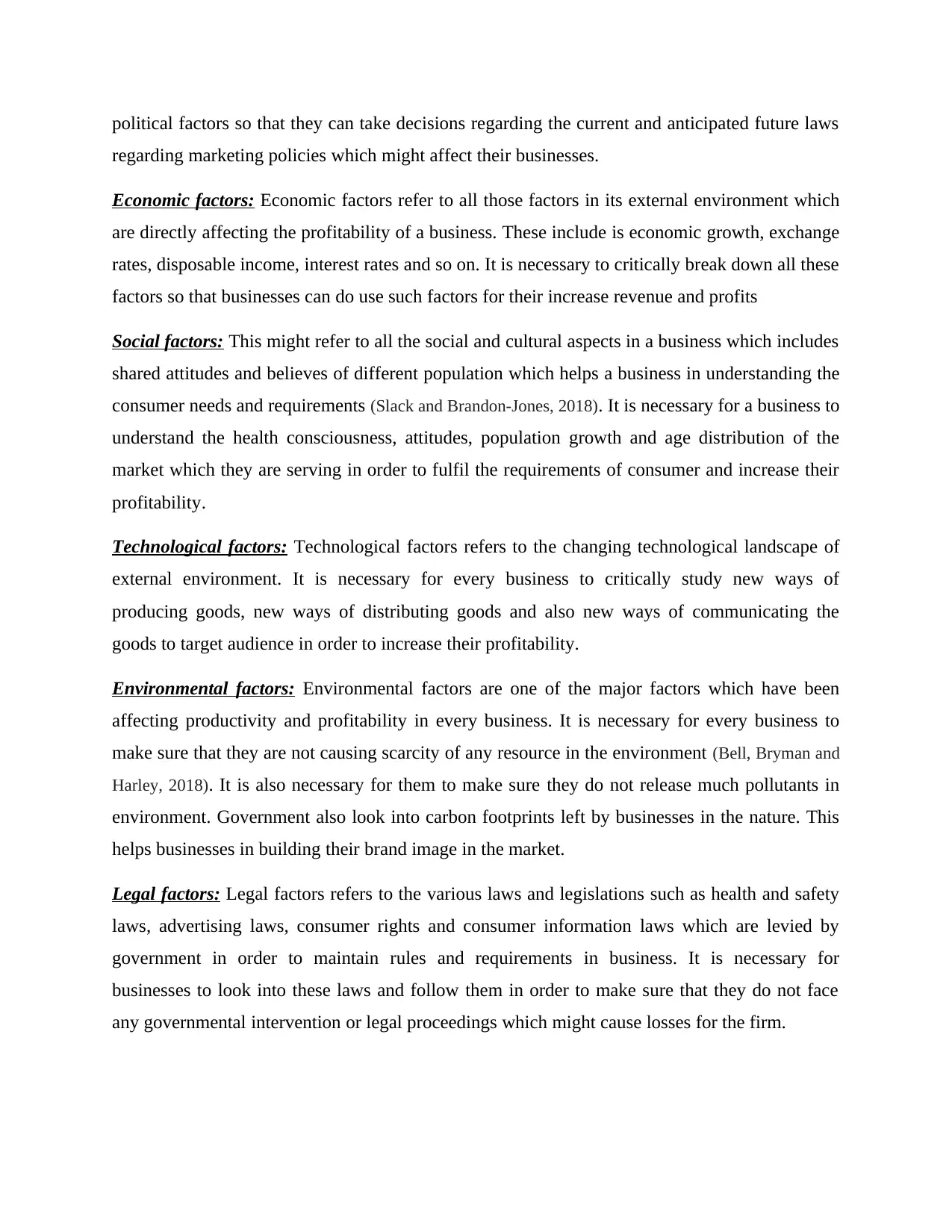
political factors so that they can take decisions regarding the current and anticipated future laws
regarding marketing policies which might affect their businesses.
Economic factors: Economic factors refer to all those factors in its external environment which
are directly affecting the profitability of a business. These include is economic growth, exchange
rates, disposable income, interest rates and so on. It is necessary to critically break down all these
factors so that businesses can do use such factors for their increase revenue and profits
Social factors: This might refer to all the social and cultural aspects in a business which includes
shared attitudes and believes of different population which helps a business in understanding the
consumer needs and requirements (Slack and Brandon-Jones, 2018). It is necessary for a business to
understand the health consciousness, attitudes, population growth and age distribution of the
market which they are serving in order to fulfil the requirements of consumer and increase their
profitability.
Technological factors: Technological factors refers to the changing technological landscape of
external environment. It is necessary for every business to critically study new ways of
producing goods, new ways of distributing goods and also new ways of communicating the
goods to target audience in order to increase their profitability.
Environmental factors: Environmental factors are one of the major factors which have been
affecting productivity and profitability in every business. It is necessary for every business to
make sure that they are not causing scarcity of any resource in the environment (Bell, Bryman and
Harley, 2018). It is also necessary for them to make sure they do not release much pollutants in
environment. Government also look into carbon footprints left by businesses in the nature. This
helps businesses in building their brand image in the market.
Legal factors: Legal factors refers to the various laws and legislations such as health and safety
laws, advertising laws, consumer rights and consumer information laws which are levied by
government in order to maintain rules and requirements in business. It is necessary for
businesses to look into these laws and follow them in order to make sure that they do not face
any governmental intervention or legal proceedings which might cause losses for the firm.
regarding marketing policies which might affect their businesses.
Economic factors: Economic factors refer to all those factors in its external environment which
are directly affecting the profitability of a business. These include is economic growth, exchange
rates, disposable income, interest rates and so on. It is necessary to critically break down all these
factors so that businesses can do use such factors for their increase revenue and profits
Social factors: This might refer to all the social and cultural aspects in a business which includes
shared attitudes and believes of different population which helps a business in understanding the
consumer needs and requirements (Slack and Brandon-Jones, 2018). It is necessary for a business to
understand the health consciousness, attitudes, population growth and age distribution of the
market which they are serving in order to fulfil the requirements of consumer and increase their
profitability.
Technological factors: Technological factors refers to the changing technological landscape of
external environment. It is necessary for every business to critically study new ways of
producing goods, new ways of distributing goods and also new ways of communicating the
goods to target audience in order to increase their profitability.
Environmental factors: Environmental factors are one of the major factors which have been
affecting productivity and profitability in every business. It is necessary for every business to
make sure that they are not causing scarcity of any resource in the environment (Bell, Bryman and
Harley, 2018). It is also necessary for them to make sure they do not release much pollutants in
environment. Government also look into carbon footprints left by businesses in the nature. This
helps businesses in building their brand image in the market.
Legal factors: Legal factors refers to the various laws and legislations such as health and safety
laws, advertising laws, consumer rights and consumer information laws which are levied by
government in order to maintain rules and requirements in business. It is necessary for
businesses to look into these laws and follow them in order to make sure that they do not face
any governmental intervention or legal proceedings which might cause losses for the firm.
Paraphrase This Document
Need a fresh take? Get an instant paraphrase of this document with our AI Paraphraser
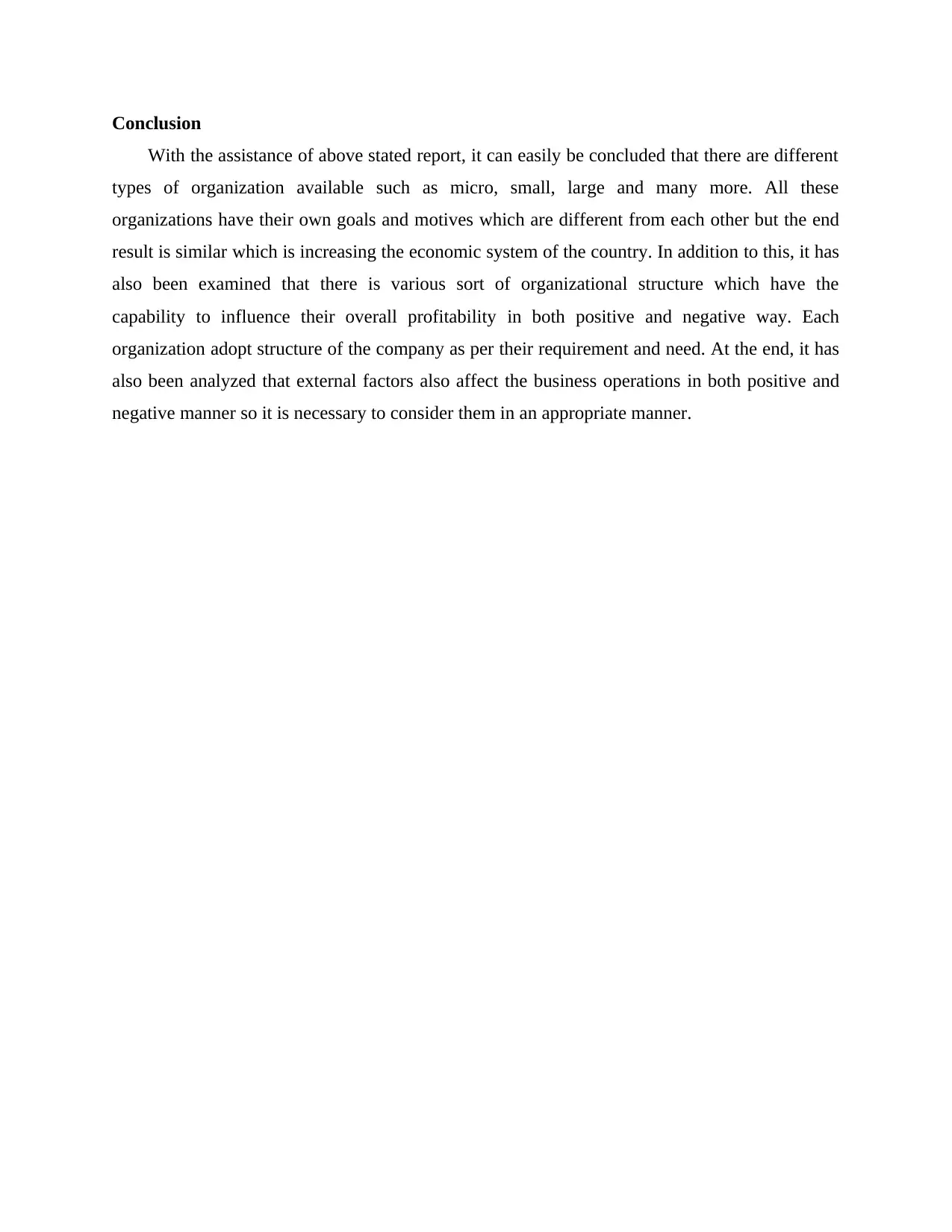
Conclusion
With the assistance of above stated report, it can easily be concluded that there are different
types of organization available such as micro, small, large and many more. All these
organizations have their own goals and motives which are different from each other but the end
result is similar which is increasing the economic system of the country. In addition to this, it has
also been examined that there is various sort of organizational structure which have the
capability to influence their overall profitability in both positive and negative way. Each
organization adopt structure of the company as per their requirement and need. At the end, it has
also been analyzed that external factors also affect the business operations in both positive and
negative manner so it is necessary to consider them in an appropriate manner.
With the assistance of above stated report, it can easily be concluded that there are different
types of organization available such as micro, small, large and many more. All these
organizations have their own goals and motives which are different from each other but the end
result is similar which is increasing the economic system of the country. In addition to this, it has
also been examined that there is various sort of organizational structure which have the
capability to influence their overall profitability in both positive and negative way. Each
organization adopt structure of the company as per their requirement and need. At the end, it has
also been analyzed that external factors also affect the business operations in both positive and
negative manner so it is necessary to consider them in an appropriate manner.
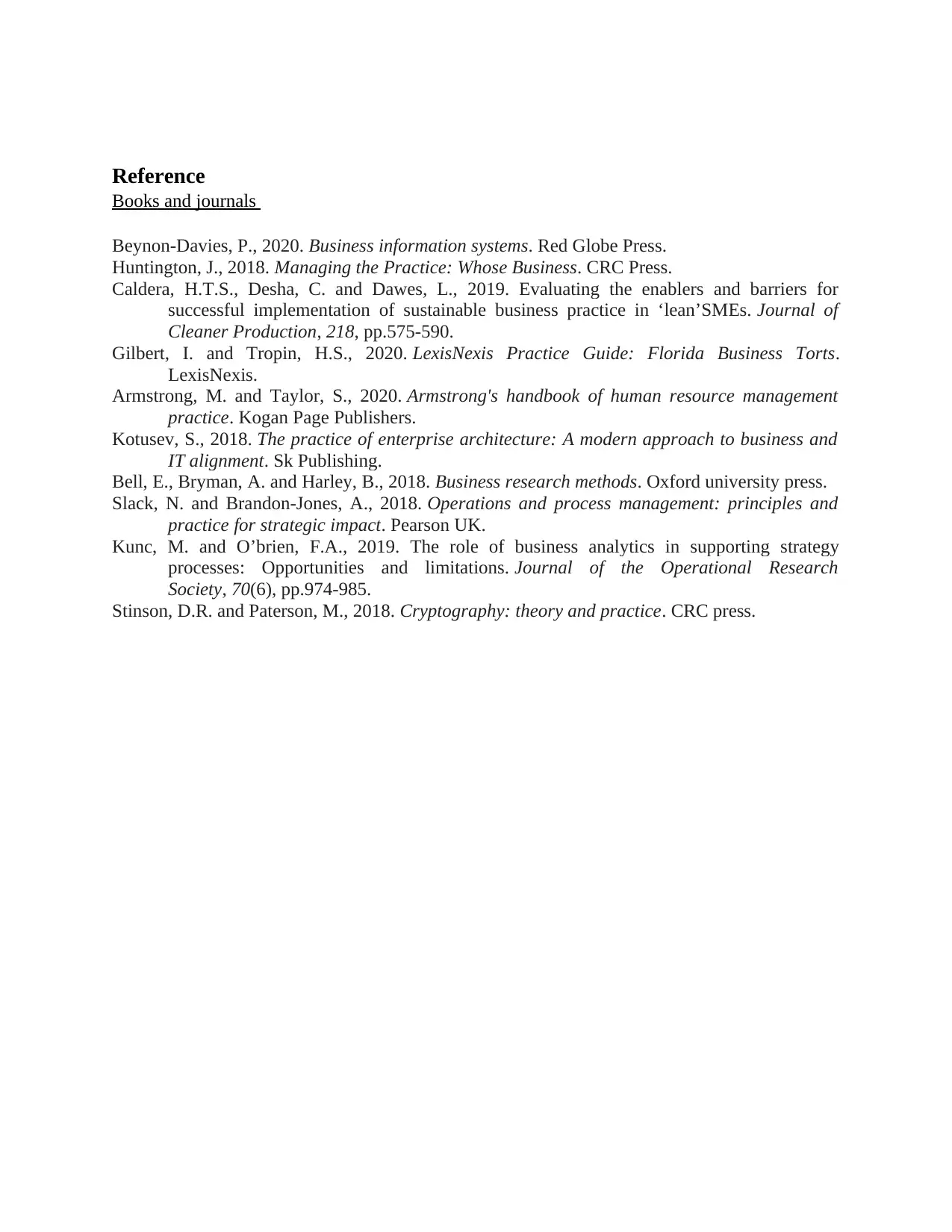
Reference
Books and journals
Beynon-Davies, P., 2020. Business information systems. Red Globe Press.
Huntington, J., 2018. Managing the Practice: Whose Business. CRC Press.
Caldera, H.T.S., Desha, C. and Dawes, L., 2019. Evaluating the enablers and barriers for
successful implementation of sustainable business practice in ‘lean’SMEs. Journal of
Cleaner Production, 218, pp.575-590.
Gilbert, I. and Tropin, H.S., 2020. LexisNexis Practice Guide: Florida Business Torts.
LexisNexis.
Armstrong, M. and Taylor, S., 2020. Armstrong's handbook of human resource management
practice. Kogan Page Publishers.
Kotusev, S., 2018. The practice of enterprise architecture: A modern approach to business and
IT alignment. Sk Publishing.
Bell, E., Bryman, A. and Harley, B., 2018. Business research methods. Oxford university press.
Slack, N. and Brandon-Jones, A., 2018. Operations and process management: principles and
practice for strategic impact. Pearson UK.
Kunc, M. and O’brien, F.A., 2019. The role of business analytics in supporting strategy
processes: Opportunities and limitations. Journal of the Operational Research
Society, 70(6), pp.974-985.
Stinson, D.R. and Paterson, M., 2018. Cryptography: theory and practice. CRC press.
Books and journals
Beynon-Davies, P., 2020. Business information systems. Red Globe Press.
Huntington, J., 2018. Managing the Practice: Whose Business. CRC Press.
Caldera, H.T.S., Desha, C. and Dawes, L., 2019. Evaluating the enablers and barriers for
successful implementation of sustainable business practice in ‘lean’SMEs. Journal of
Cleaner Production, 218, pp.575-590.
Gilbert, I. and Tropin, H.S., 2020. LexisNexis Practice Guide: Florida Business Torts.
LexisNexis.
Armstrong, M. and Taylor, S., 2020. Armstrong's handbook of human resource management
practice. Kogan Page Publishers.
Kotusev, S., 2018. The practice of enterprise architecture: A modern approach to business and
IT alignment. Sk Publishing.
Bell, E., Bryman, A. and Harley, B., 2018. Business research methods. Oxford university press.
Slack, N. and Brandon-Jones, A., 2018. Operations and process management: principles and
practice for strategic impact. Pearson UK.
Kunc, M. and O’brien, F.A., 2019. The role of business analytics in supporting strategy
processes: Opportunities and limitations. Journal of the Operational Research
Society, 70(6), pp.974-985.
Stinson, D.R. and Paterson, M., 2018. Cryptography: theory and practice. CRC press.
⊘ This is a preview!⊘
Do you want full access?
Subscribe today to unlock all pages.

Trusted by 1+ million students worldwide
1 out of 9
Related Documents
Your All-in-One AI-Powered Toolkit for Academic Success.
+13062052269
info@desklib.com
Available 24*7 on WhatsApp / Email
![[object Object]](/_next/static/media/star-bottom.7253800d.svg)
Unlock your academic potential
Copyright © 2020–2025 A2Z Services. All Rights Reserved. Developed and managed by ZUCOL.





